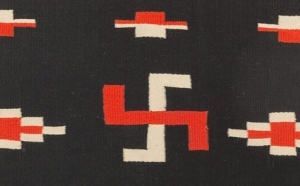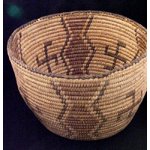Native American Symbols – Yei
Yei is a shortened version of *YeiBiChi, a holy figure in the Navajo culture. Yeis are the supernatural beings that allow communication between the Navajo people and their Gods. One Navajo artist told me, “They are the keepers of the door to the other world.”
YeiBiChi are the masked human dancers impersonating the Yei deities for ceremonial purposes.
© 2010 Horsekeeping © Copyright Information

Sterling Silver Navajo Yei
The yei is a mythical figure that symbolizes various healing powers. There are various yeis, one of which is Rainbow Man (a separate post coming). Yeis have wisdom to share with man to help him live in harmony, survive and behave in the right way.
Appearing as Petroglyphs (Rock Art) in North America, Yei figures are often used in healing ceremonies to restore a person’s balance or hozho.

Navajo Yei Naja Sterling Silver Pendant
Hozho is a Navajo word that depicts the quality of harmony but it means so much more. It is not only gaining harmony but maintaining it. It is a sense of walking in beauty, something that is achievable by all because there is a sense of rightness in the core of each person. To be in true hozho, one must embrace the world and the environment and be a part of it while still striking a clear tone of one’s own existence and being.
Sometimes to restore a person’s hozho, a hataalii (Navajo healer) also known as a Singer or a Medicine Man is called in. the hataalii incorporates the appropriate yei figure into the sand painting (dry painting) near the person’s home that needs healing. The painting is made of sand and other colored materials such as pollen, crushed stones and flowers. Once the sand painting is completed, the ailing person sits on the sand painting and the illness is drawn out of the person into the sand. That night the healer gathers up all of the material used in the painting and scatters it to the Four Directions. The ceremony can last up to 9 days. This type of healing sand painting is a private ceremony, not viewed by those outside the family.
The other type of sand painting is created for the sake of representing Native American art. It is put together on a board to remain as a permanent piece of art – the materials are sprinkled on the glued surface. Any symbols incorporated are, hopefully, used in a manner that is not disrespectful. It is said that sand painting art is not “completed” like a healing sand painting is, but it does give a close representation.
Yeis were also often woven into rug designs most notably from the Shiprock New Mexico area and northeast Arizona. Since the use of yeis in sand paintings is meant to be a sacred, temporary use and discarded when the healing has taken place, when yeis were first woven into rugs in the 1920’s, they were taboo. To have a sacred figure that is used for healing to be used in a permanent way on display was just not right. Today’s woven rugs are justified in a similar way as is the sand painting art – they are for display only for their artistic merit, they are not used for worship or as prayer rugs.
There are male and female yei figures. Female yei have square heads and male yei are depicted with round heads.

Navajo Sterling Silver Yei Square Head

Navajo Yei Round Head
The figures can be found depicted standing upright, curved, angled and in a three-sided square.

Navajo Sterling Silver and Turquoise Yei
*spelling variations also seen: Yeii, YeiBiChei, YeiBeiChai, YeiBeChai, YeBiChai)




























